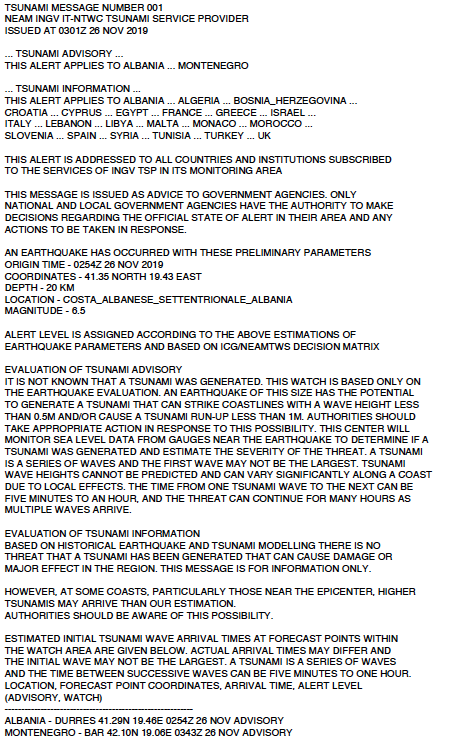
Alert message of 26.11.2019 in Albania
The purpose of the alert system is to ensure the effective and timely dissemination of warning messages in the event of seismic events which may result in tsunamis, activating the national civil protection system for implementing emergency measures and at the same time allowing countries receiving messages from the CAT-INGV to activate their defence systems.
Due to the high seismicity of the area, the coasts of all the countries bordering the Mediterranean Sea are at risk of tsunamis. For this reason, the Italian system operates within an international system coordinated by UNESCO, using criteria and procedures common to all countries, established by the ICG / NEAMTWS (Intergovernmental Coordination Group of the Tsunami Alert System of the North Atlantic, Mediterranean and related basins).
In this framework, the CAT-INGV monitors the earthquakes occurring within its area of jurisdiction, the Mediterranean basin. This monitoring, which takes place 24 hours a day, seven days a week, is based on three types of estimates:
- • rapid estimate of the location (hypocentre) and magnitude of the earthquake;
- • rapid estimate of the potential level of tsunami alert, based on the location and magnitude of the earthquake (through the decision matrix) for a set of predefined points, called "forecast points" (FP), located in major ports and along the coasts of the Italian peninsula and the Mediterranean.
- • rapid calculation of the arrival times of the possible tsunami at these FPs.
This information is used to generate and send tsunami warning messages in case of earthquakes of magnitude equal to or greater than 5.5. The severity of the alert level depends on the magnitude of the earthquake, on its position and depth, and on the distance of each forecast point from the epicentre, and is determined by the Decision Matrix.
An information message or tsunami alert is issued should the earthquake occur within the area of jurisdiction of the CAT-INGV, the magnitude is equal to or greater than 5.5, the epicentre is at sea or within 100km inland, the depth of the hypocentre is less than 100km. This message contains the following information: earthquake origin time (time), location (latitude and longitude of the epicentre), earthquake magnitude, (intensity) estimate of the alert level and theoretical arrival time at the forecast points.
It is important to know that the accuracy of the estimates depends on a complex processing of seismic data, which proceeds by successive iterations (the repetition of processing cycles necessary to approach the solution) and requires the time and computational power necessary to acquire and process the data from the monitoring stations.
The Early-Est program (LINK), adopted by the CAT-INGV, performs a first localisation using the data of a few stations and elaborates a series of successive solutions at intervals of one minute, using the data of an increasing number of seismic stations, decreasing the margin of error each time.
For Civil Protection purposes it is necessary to find a good compromise between the speed of calculation and the accuracy of the results.
In general, the accuracy of the estimates used to process the tsunami warning messages and the processing speed depend on the quantity of data recorded by the seismographs and on the algorithms used. The greater the number of seismographs the seismic waves reach, the more accurate the localisation and magnitude estimate will be.
As a result, the first available results will be more uncertain than later ones. For this reason, initial estimates, generally available three to four minutes after the earthquake, are not used to generate a tsunami warning message.
This information is formatted according to a predefined international protocol, with only one but very important difference: while the messages sent to the NEAMTWS member states are in English, as required by international standards, the warning messages intended for the components of the National Civil Protection System (National Department, Regions, Prefectures, Municipalities etc.) are sent in Italian.



